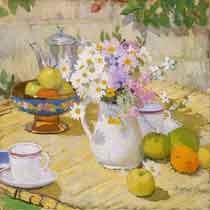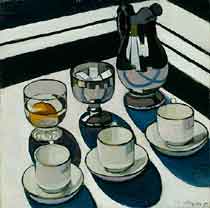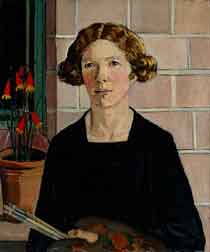Margaret Preston (1875-1963), although born in Adelaide, had a long and intimate relationship with the Art Gallery of New South Wales, from her first visit to the institution at the age of twelve. Preston was later to claim that the admiring looks directed to artists copying Gallery paintings persuaded her to become an artist. She subsequently moved to Melbourne and trained at the National Gallery Schools, before settling in Adelaide where she established her early career. Living in Paris and London over 1912-1919 Preston did not re-establish her connection with the Art Gallery of New South Wales until she returned to Australia in 1919 and settled in Sydney in 1920. In that year the Gallery became the first of Australia's public art museums to acquire the artist's modernist work, by purchasing the spectacular early painting Summer 1916, which will be featured in the forthcoming retrospective. Many purchases followed and the Gallery now holds twenty-four paintings and over eighty prints by Preston, including some of the most significant examples of the artist's work. The Art Gallery also possesses an important archive, bequeathed by the artist's husband William Preston, which includes Margaret Preston's library -with many books annotated in her hand - as well as photographs, lecture notes and Preston's collection of art magazines.
The Art Gallery of New South Wales Directors Will Ashton and later Hal Missingham acknowledged Margaret Preston as one of Australia's most influential modernists, and actively supported her role as a spokesperson for Australian art over many years. In 1929 the Gallery's Trustees invited Preston to paint a self-portrait for the collection - the first such request made to an Australian woman artist. The painting, on permanent display, depicting a youthful Preston with brushes and palette in hand, has become one of the most popular early modernist works at the Gallery. In 1938, at the invitation of the Gallery's Trustees, Preston delivered five major public lectures under the aegis of the Carnegie Corporation Education Scheme. These were followed up with a series of lectures on painting, print and craft techniques in 1939. Preston also became an enthusiastic guide for children's tours of the Art Gallery of New South Wales' collections. In 1942 she was asked, again by the Gallery Trustees, to present a major exhibition of her work, in conjunction with a Gallery survey of the art of William Dobell. The exhibition included many of Preston's most significant works, and these too will be re-assembled for the 2005 exhibition.
Margaret Preston lived in Sydney for forty years. Over the 1920s and 30s her art became synonymous with the city and its harbour - her bright exuberant paintings and woodblock prints depicting landmarks of the city; Circular Quay, the Harbour bridge, and the coves and corners of Mosman where she lived. Sydney's flora and fauna also became consistent features of her still-lifes. She was influenced particularly by the colour print-makers of the Japanese Ukiyo-e ('Floating world') movement, by European post-impressionism, and by the great traditions of Chinese landscape painting, and worked to synthesise these elements in her art.
Preston's rise to extraordinary prominence in the 1920s was facilitated by another Sydney personality, the artist, publisher and later Gallery Trustee Sydney Ure Smith, who consistently featured Preston's art in his influential magazines Art in Australia and Home over these decades, and promoted the work of the artist in major travelling exhibitions.
Preston's vital, energetic and sometimes explosive personality affected all who met her: her widely proclaimed opinions on the state of art in Australia (and many other topics), and on the need to build a new 'national art' brought her both advocates and enemies. As Hal Missingham was to famously remark, Margaret Preston 'is an enemy of the dull'.
The artist exhibited continuously in Australia for nearly fifty years, and has significant holdings of works in all Australian state collections. Over one hundred and eighty of her works, ranging from oil paintings, woodblock prints, monotypes, colour stencils and ceramics, from Australian public galleries and private collections, and from overseas lenders, will be featured in the Gallery's forthcoming exhibition.
If Preston rose to prominence in the inter-war decades as an innovative modernist and a superb, exuberant colourist, it is in her recognition of the exceptional qualities of Aboriginal art that her greatest significance lies. Preston worked from the 1920s to absorb, incorporate and transform European modernist tendencies into a distinctly Australian vision. Strongly drawn to Aboriginal paintings, artefacts and rock carvings when this art was still very much the province of anthropologists, Preston was the first non-Aboriginal artist to see the 'art of the First Australians' as one of the greatest art forms of the world. She was also one of the few Australian artists to travel to remote communities and sites in Central and Northern Australia in the1940s to view Indigenous carvings, paintings, and contemporary works. Living in Berowra on the outskirts of Sydney in the 1930s, Preston had also studied the extensive rock carvings of the area, and joined the Anthropological Society of New South Wales; accompanying the society on several trips to view rock carvings and paintings in regional New South Wales. For Preston Aboriginal art became the central platform from which an intrinsically Australian culture could be built. Her incorporation of Aboriginal principles of design into paintings and prints; and her appropriation of Aboriginal motifs in still-life studies, and in the landscapes which came increasingly to occupy her in the 1940s, has ensured both her popularity and her notoriety since this time.
While in one sense the forthcoming Retrospective exhibition represents the culmination of a relationship between the artist and the Art Gallery of New South Wales which extended over six decades, Margaret Preston's art and attitudes are of national significance. The exhibition and its accompanying publication will provide a comprehensive account of Preston's sixty years of remarkable creativity as Australia's most celebrated modernist. Within this project there will be a particular focus on Preston's changing relationship with Aboriginal art, and on the remarkable products of the artist's dramatic late move - after forty five years of almost exclusive still life production - into the area of landscape. It is all of these aspects of her art which establish Margaret Preston's central place in the wider history of Australian art. | | 
Margaret Preston
Summer 1916
oil on canvas
Purchased 1920

Margaret Preston
Implement Blue 1927
oil on canvas
Gift of the artist 1960

Margaret Preston
Self portrait 1930
oil on canvas
Gift of the artist at the request of the Trustees 1930

Margaret Preston
I lived at Berowra 1941
oil on canvas
Purchased 1941

Margaret Preston
Sydney Heads (2) 1925
woodcut, black ink, handcoloured with gouache on thin cream laid tissue
Gift of Mrs Alison Brown 1968
Purchased 1941
|